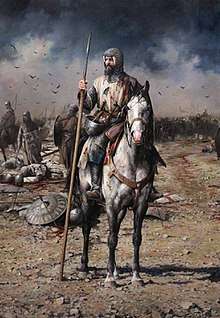Monaspa

The Monaspa or Mona-spa (Georgian: მონასპა; lit. the "army of [military] servants") was an elite unit of the Georgian army, from the 11th to the 12th centuries, whose members performed the dual roles of both personal bodyguards to the Georgian monarchs and standing army. The monaspa were well trained and heavily armed mounted warriors used as shock cavalry, numbering some 5000 men (Mona).[2] They were known for being primarily composed of landless nobles and foreign mercenaries, specifically North Caucasian steppe nomads: Alans, Kasogs and Kipchaks of which approximately 14000 Kipchak families were resettled in Georgia's frontier regions in 1118 and baptized.[3]
The "Monaspa" was entirely dependent on the king and had no bonds with the feudal nobility.[4] Monaspa along detachments provided by feudal lords and mercenaries were commanded either by the monarch or an amirspasalar.[5]
In 1118, after successful completion of David IV's military reform, a Royal Guard of about 5000 horsemen was formed. The king personally directed the training and equipment of his troops. The new type of army would stand up better to the Seljuk Turkish military organization, and then go over to a methodical offensive with the aim of expelling the Seljuks first from Georgia and then from the whole Caucasus. During the period of 106 years, the Georgian army (The most crucial and core component was the Monaspa guard) won four great victories over the Seljuk Turks in the battles of Ertsukhi (1104), Didgori (1121), Shamkori (1195) and Basiani (1205). This organisation of the army created by David remained practically unchanged throughout the 12th century.
In the late 12th century most of the Monaspa became feudal landholders and part of new Georgian military aristocracy. After 1184 Monaspa's are not mentioned. Some monaspa members gradually gained prominence at the Georgian royal court and acquired their status during the reign of George II and Queen Tamar: Sargis Mkhargrdzeli, Ivane Mkhargrdzeli, Zakaria Mkhargrdzeli, Apridon, Kubasar etc.
See also
References
- ↑ "FERRER –DALMAU: El espíritu del jinete", Diario YA
- ↑ Valeri Silogava, Kakha Shengelia (2007), Caucasus University Publishing House, History of Georgia from the Ancient Times Through the "Rose revolution", ISBN 978-9994086160
- ↑ (Roux 1997, p. 242)
- ↑ Kalistrat Salia, N. Salia, (1983),History of the Georgian nation - Georgia (Republic),
- ↑ Alexander Mikaberidze, (Jan 1, 2007), Historical Dictionary of Georgia - Scarecrow Press, ISBN 978-0810855809